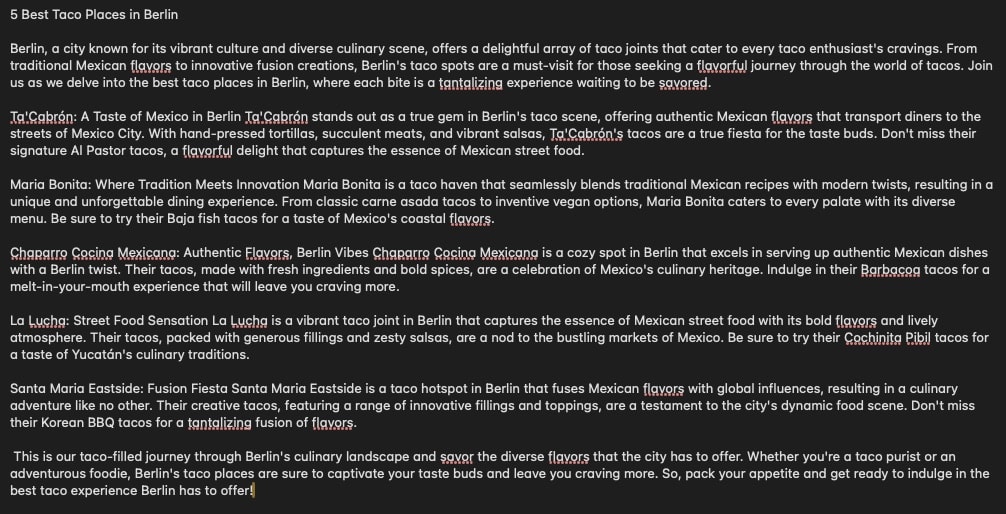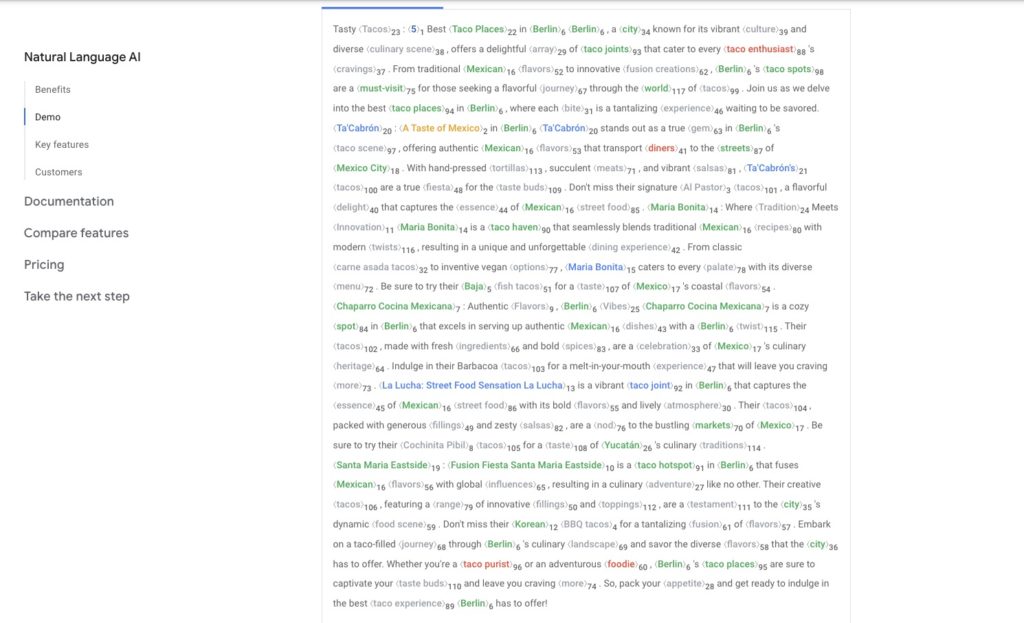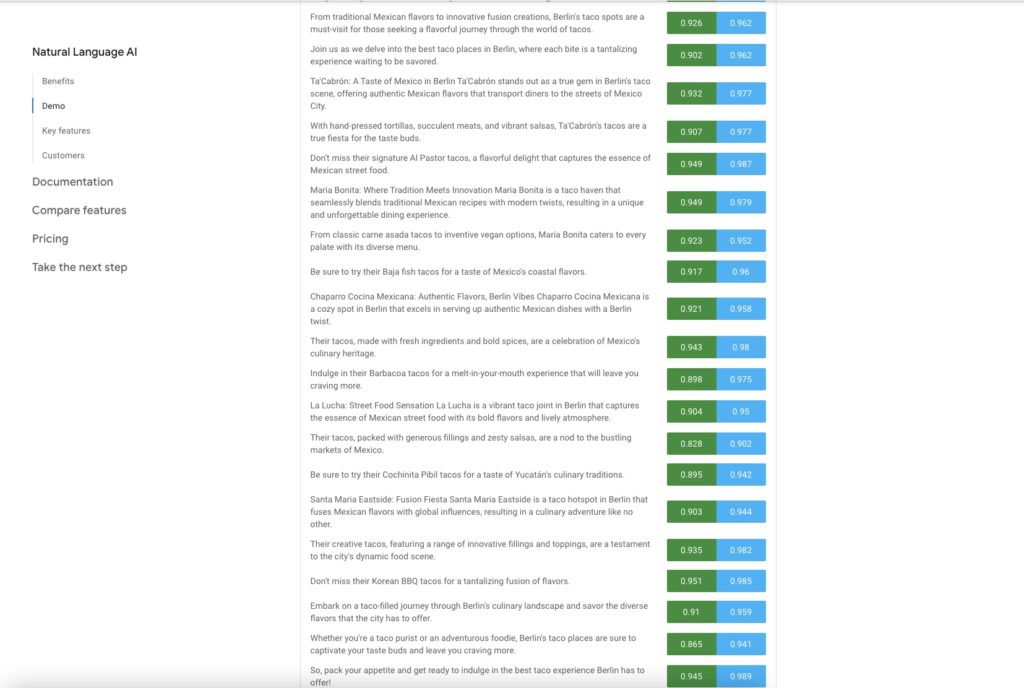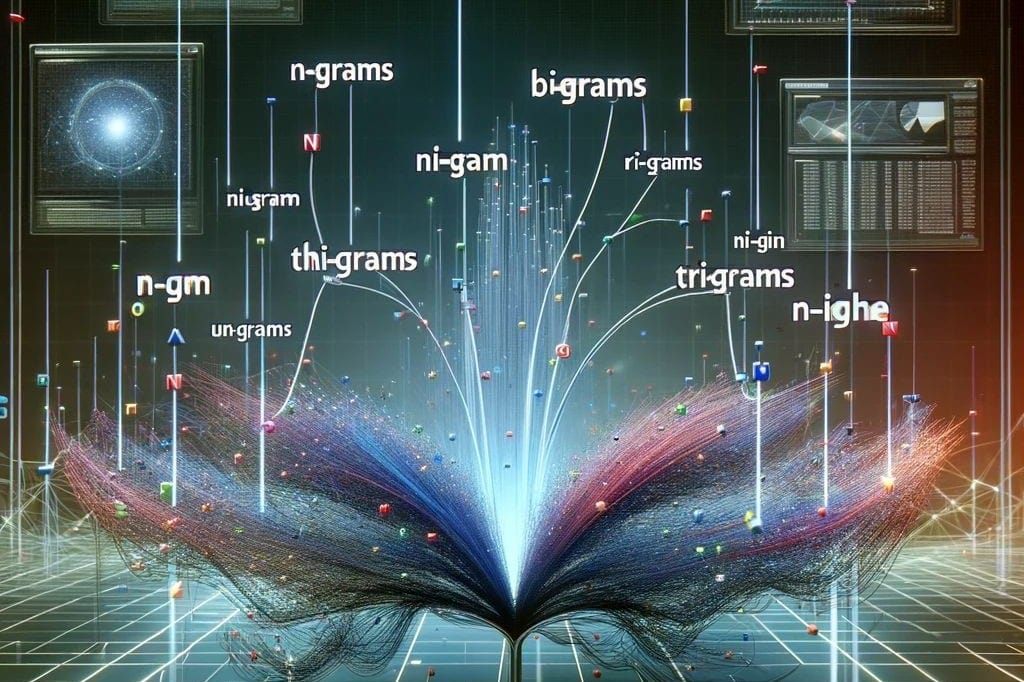Last week I shared a post on Linkedin about N-grams and a related content creation prompt that utilizes semantic relationships in content creation by AI.
The integration of N-Grams and semantic relationships into AI-driven content creation offers a unique opportunity to explore new frontiers of digital expression. This exploration led to the development of a specialized prompt that focuses on creating content that is not only engaging, but also highly relevant and contextual.
I slightly modified the shared prompt and wrote a content about the best taco places in Berlin (although I've never visited any of them :)). Here are the results of the unedited ChatGPT output typed directly into Google's NLP.
N-Gram Prompt
"Objective: to improve SEO content creation with a focus on optimizing NLP results through sophisticated analysis of N-grams and Uni-Grams. The goal is to create text that not only ranks well in search engines, but is also readable and relevant to the target audience.
Instructions: Analyze N-grams and uni-grams: Prioritize the use of N-grams and uni-grams to better understand context, topic relevance, and keyword distribution. Analyze the most successful content in the target niche to identify patterns and frequency of specific N-grams and uni-grams that contribute to high SEO rankings.
Content creation: When creating content, strategically incorporate the identified N-grams and uni-grams to increase thematic authority and semantic richness. Make sure that the use of these elements in the text feels natural and adds value for readers.
Keyword optimization: Ensure a balance between keyword inclusion and the seamless integration of N-grams and Uni-Grams. This approach should aim to improve content visibility for both broad and specific search queries and align with user intent and search behavior. Highlight these keywords in bold.
Readability and engagement: While focusing on n-grams and uni-grams, you should focus on creating engaging, reader-friendly content. The goal is to satisfy search engine algorithms and human readers alike, resulting in higher engagement rates and longer dwell time.
Feedback loop: Use analytics tools to monitor content performance in terms of SEO metrics and user engagement. Use the insights gained to refine the strategy around N-Grams and Uni-Grams and continuously improve the quality and effectiveness of future content.
Expected results: The content created should demonstrate a sophisticated understanding of the target domain, with N-Grams and Uni-Grams skillfully woven into the narrative to boost SEO performance. This approach is expected to lead to better search result rankings, increased organic traffic and improved user engagement."
After the prompt, you can write something like:
"Once you understand the goals, I'll give you the topic, language and other instructions for the blog post."
Not to mention that I've already customized the above prompt a bit as it's a bit generic. To make it suitable for travel, travel tips, I would have to change small things.
ChatGPT 4 Output
I don't want to share the text version because I don't want to rank for search terms like "taco restaurants in Berlin" 🙂

Google Natural Language AI results
So I copied the content directly and pasted it on this website:
There is a section called "Try the API" where you can paste your content to get some results from the Google tool.
In the first image you can see the semantically related keywords that result from the overall flow of my content.

On the second screenshot, you can also see how Google rates each of your sentences in relation to the overall content.

There are 2 more tabs where you can check the content: Moderation and Categories. I have written more about what these tabs mean and what they do below.
So, that's it for now. Here's how you can customize your AI-generated content and make it more accessible to users and Google. For those who are interested, I've written some more information about Google NLP below.
What is Google NLP?
Google NLP stands for Google Natural Language Processing. It is an advanced AI technology. Its aim is to understand, analyze and interpret human language.
This enables computers to understand texts and spoken words almost like humans. This technology analyzes text data. It recognizes speech patterns, moods, opinions and entities such as people, places and organizations. It also understands the relationships between words.
Google NLP offers various APIs and tools that can be integrated into applications and services to make them smarter and more interactive. The main functions include:
- Entity recognitionIdentifies important elements in a text, such as people, places and organizations.
- Sentiment analysis: Evaluates whether the mood in a text is positive, negative or neutral.
- Text classification: Assigns texts to specific categories or topics.
- Syntax analysis: Breaks sentences down into their grammatical components and identifies the relationships between words.
Google NLP makes a significant contribution to making the interaction between people and computers more natural and efficient.
It revolutionizes how we interact with technology and enables a wide range of applications, from improved search engines to intelligent chatbots and personal assistants.
Google Natural Language AI functions
Google Natural Language AI offers various functions for analyzing text. Here are explanations of the main functions in German:
- EntitiesThis function recognizes persons, places, organizations and other relevant elements in the text. Entities are identified and classified, and their meaning in context can also be determined. This helps to quickly identify the key components of a text.
- SentimentSentiment analysis evaluates the emotional tone of a text, i.e. whether the opinions and attitudes expressed in it are positive, negative or neutral. It can be carried out at various levels, from analyzing the entire document to individual sentences or entities.
- ModerationThis feature helps to identify inappropriate content in a text, such as offensive language, hate speech or other content that is not suitable for certain audiences. Moderation tools are important for platforms that want to automatically filter and moderate content to ensure a positive and safe environment.
- CategoriesCategorization assigns texts to thematic categories. This function analyzes the content and structure of a document in order to assign it to one or more predefined topics. This makes it easier to organize and find information in large amounts of data.
These features of Google Natural Language AI enable in-depth analysis of text and provide valuable insights for a variety of applications, from content moderation and sentiment analysis to entity recognition and thematic categorization.
